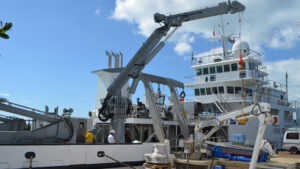BIOS’s R/V Atlantic Explorer Sports New Hydraulic Deck Crane

Research vessels are one of ocean science’s most valuable workhorses, providing researchers with access to remote waters and safely carrying scientific equipment and personnel around the world. Modern vessels must also be capable of simultaneously supporting research in a variety of disciplines (e.g., oceanography, geology, engineering, and even atmospheric science). As a result, research vessels are outfitted for both general operations and discipline-specific tasks.
One vital piece of deck equipment on any research vessel is the crane. While cranes are normally used solely for lifting equipment, many vessels are now utilizing specially designed and engineered deck cranes to support onboard science missions.
In January one such crane was installed aboard the R/V Atlantic Explorer during its annual shipyard visit, marking the completion of a three-year collaborative effort between the National Science Foundation (NSF) and BIOS. The new crane, which features an extendable knuckle boom design, offers several improvements over the former crane: improved safety for cargo and equipment loading, better design and construction allowing for use of the crane during science overboard deployments, greater lifting capacity and reach, and remote wireless operation.
With $875,000 in funding from NSF, BIOS worked to develop a design, specification, and purchasing process that could be used for future NSF purchases of deck equipment for science missions on vessels in the University-National Oceanographic Laboratory System (UNOLS) research vessel fleet. As part of this process, engineers envisioned every conceivable way the crane might be used to deploy scientific equipment and then determined safe operating loads and configurations for each, compiling the results in a comprehensive reference document.
Glosten Associates, a naval architecture and marine engineering company in Seattle, Washington, was employed for the preliminary engineering required to develop a construction specification for the new crane. Appleton Marine, Inc., which recently built the cranes for the University of Alaska’s R/V Sikuliaq, was chosen to manufacture the crane due to their willingness to take on a project with so many engineering requirements. Prior to delivery the crane was put through vigorous factory acceptance trials, with both the BIOS Marine Superintendent, Ron Harelstad, and Glosten Associates Engineer in attendance.
With this new piece of equipment, the R/V Atlantic Explorer is better able to perform three different—and crucial—operations: cargo handling alongside the dock, science equipment moves or overboard operations at sea, and personnel lifts in any conditions. This translates into additional opportunities for the R/V Atlantic Explorer to be effectively utilized in upcoming science missions, both with BIOS faculty and research programs as well as visiting scientists.
